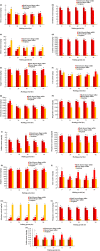Effect of malting period on physicochemical properties, minerals, and phytic acid of finger millet (Eleusine coracana) flour varieties
- PMID: 30349675
- PMCID: PMC6189621
- DOI: 10.1002/fsn3.696
Effect of malting period on physicochemical properties, minerals, and phytic acid of finger millet (Eleusine coracana) flour varieties
Abstract
Background: Deficiency of essential minerals is a widespread nutritional disorder in the world, particularly in developing economies. Poor mineral accessibility from foods is a major contributing factor to deficiency and associated health problems. This study investigated the effect of malting on minerals, phytic acid, and physicochemical properties of finger millet varieties. Sorghum was used as external reference. Mineral composition was analyzed using an inductively coupled plasma atomic emission spectroscopy (ICP-AES) and mass spectroscopy (ICP-MS).
Results: Data showed that finger millet is rich in macroelements and trace elements. Malting for 24 hr reduced mineral content of the grains except sodium. Increase in the minerals was observed beyond 48 hr of malting particularly at 96 hr. Successive decrease in phytic acid of the grains was not observed with malting time. Malting did not result in any significant change in the physicochemical properties of the grains.
Conclusion: ICP-AES/MS showed that finger millet contain a variety of minerals in amounts that were not previously reported, and malting the grain for 72 to 96 hr positively affected the minerals. Changes in phytic acid suggest that phytate undergoes dissociation during malting rather than a degradation of phytic acid. Potential exists for utilization of finger millet as functional ingredient to augment important minerals in weaning, geriatric, and adult foods for health promotion.
Keywords: Eleusine coracana; ICP‐MS; malting; minerals; phytic acid.
Figures


Similar articles
-
Effect of traditional fermentation and malting on phytic acid and mineral availability from sorghum (Sorghum bicolor) and finger millet (Eleusine coracana) grain varieties grown in Kenya.Food Nutr Bull. 2002 Sep;23(3 Suppl):241-5. Food Nutr Bull. 2002. PMID: 12362804
-
Bioaccessible mineral content of malted finger millet (Eleusine coracana), wheat (Triticum aestivum), and barley (Hordeum vulgare).J Agric Food Chem. 2010 Jul 14;58(13):8100-3. doi: 10.1021/jf100846e. J Agric Food Chem. 2010. PMID: 20560601
-
Malting Period Effect on the Phenolic Composition and Antioxidant Activity of Finger Millet (Eleusine coracana L. Gaertn) Flour.Molecules. 2018 Aug 21;23(9):2091. doi: 10.3390/molecules23092091. Molecules. 2018. PMID: 30134529 Free PMC article.
-
Varietal and processing influence on nutritional and phytochemical properties of finger millet: A review.Heliyon. 2022 Dec 14;8(12):e12310. doi: 10.1016/j.heliyon.2022.e12310. eCollection 2022 Dec. Heliyon. 2022. PMID: 36590554 Free PMC article. Review.
-
Finger millet (Ragi, Eleusine coracana L.): a review of its nutritional properties, processing, and plausible health benefits.Adv Food Nutr Res. 2013;69:1-39. doi: 10.1016/B978-0-12-410540-9.00001-6. Adv Food Nutr Res. 2013. PMID: 23522794 Review.
Cited by
-
Utilisation of Amaranth and Finger Millet as Ingredients in Wheat Dough and Bread for Increased Agro-Food Biodiversity.Foods. 2022 Mar 22;11(7):911. doi: 10.3390/foods11070911. Foods. 2022. PMID: 35406998 Free PMC article.
-
From 'Farm to Fork': Exploring the Potential of Nutrient-Rich and Stress-Resilient Emergent Crops for Sustainable and Healthy Food in the Mediterranean Region in the Face of Climate Change Challenges.Plants (Basel). 2024 Jul 11;13(14):1914. doi: 10.3390/plants13141914. Plants (Basel). 2024. PMID: 39065441 Free PMC article. Review.
-
Optimization of spray-drying process for the microencapsulation of L. Plantarum (MCC 2974) in ultrasound hydrated finger millet milk.Food Sci Biotechnol. 2024 Feb 24;33(12):2777-2788. doi: 10.1007/s10068-024-01532-0. eCollection 2024 Sep. Food Sci Biotechnol. 2024. PMID: 39184992 Free PMC article.
-
Effect of malting on physicochemical, antioxidant, and microstructural properties of finger millet (Eleusine coracana) flours.Food Sci Nutr. 2023 Oct 31;12(1):547-563. doi: 10.1002/fsn3.3790. eCollection 2024 Jan. Food Sci Nutr. 2023. PMID: 38268874 Free PMC article.
-
Ultrasound-assisted hydration of finger millet (Eleusine Coracana) and its effects on starch isolates and antinutrients.Ultrason Sonochem. 2021 May;73:105542. doi: 10.1016/j.ultsonch.2021.105542. Epub 2021 Mar 26. Ultrason Sonochem. 2021. PMID: 33819868 Free PMC article.
References
-
- Agte, V. V. , Gokhale, M. K. , & Chiplonkar, S. A. (1997). Effect of natural fermentation on in vitro zinc bioavailability in cereal‐legume mixture. International Journal of Food Science & Technology, 31, 29–32. 10.1046/j.1365-2621.1997.00372.x - DOI
-
- Association of Official Analytical Chemists (AOAC) (2000). Official methods of analysis (17th ed.). Washington, DC: Association of Official Analytical Chemists.
-
- Chethan, S. , Sreerama, Y. N. , & Malleshi, N. G. (2008). Mode of inhibition of finger millet malt amylases by the millet phenolics. Food Chemistry, 111, 187–191. 10.1016/j.foodchem.2008.03.063 - DOI
LinkOut - more resources
Full Text Sources

